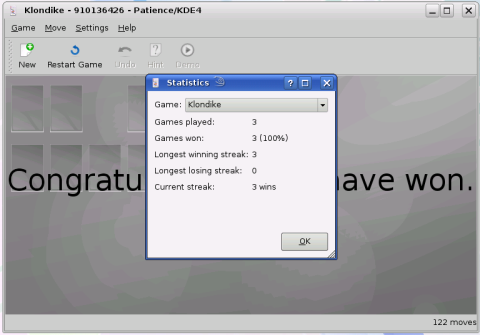In praise of KDE Edu and Games
September 22, 2007
When learning French, the toughest aspect was always learning idioms or figures of speech. Wait, did she just say that she put her slipper in the butt of a gorilla? OoooOOohh, that’s right, that phrase means that she’s hungry for soup! How could I ever forget? Thank goodness I came out of the womb knowing English, because I sure as hell wouldn’t want to learn this lawless language. So of course, to infuriate my gentle international readers, I always try to use a phrase once per blog that can’t possibly be understood. Yes, I’m sabotaging your self-esteem. But well adjusted people don’t read my blog; they’re out playing frisbee or renting the movie Gymkata.
This week’s winner? “Canary in a coalmine.” Now, the phrase had a slightly more lethal origin, but nowadays just means “harbinger of the future” or maybe a bellwether. (wait, does that qualify as another ridiculous term?) Can my rambling possibly have anything to do with the title of this blog? Of course, because I’m referring to my opinion (remember: this singular opinion carries the weight of seven to eight others) that the KDE Edu and Games applications have been health indicators for the success of 4.0 and on into the 4 series. And they have been for some time now.
Small, fairly self-contained applications, each which can be effectively managed by just a couple of people. These applications may be heavy on the new graphics wizardry available to us, but may not have deeper or denser logic like a Kontact or K3B or Krita. It seems like a very welcoming environment to participate in, and I’ve written before about always lowering the barriers to entry to new programmers or community participants in general. Smaller applications also can be a scout team to flush out basic functional questions and show stability in our Pillars and KDE libs. Once Plasma matures a bit, I think you’ll see the same movement and activity (as if Plasma isn’t sprouting up new widgets weekly already). So when groups fare well with smaller and more nimble endeavor like plasmoids and games, it portends well to the eventual successes of larger efforts. Further, games and educational applications have always needed good usability, because everything needs to be self-evident.
Personally, it’s been reassuring to see the Edutainment groups posting screen shots, blogging about progress, hosting polishing meetings and such. These groups are pacing the larger and more cumbersome technologies and applications, acting as the Lewis and Clarks of KDE. They’re self-organized and have honest self-appraisals as seen here. If that’s not enough, the portability of educational and gaming applications is shown when I try out a liveCD like openSUSE 10.3 RC1 from beineri’s blog and see a KDE 3.5 desktop with KDE 4.0 games. As proof, here’s me dominating Klondike:
Right away, we may see this very “hybrid approach” as distros dip their toes in the water (yes, a third ridiculous phrase!) and keep the 3.5 desktop but slide in 4.X applications and libraries.
More proof of these groups’ progress? Our aacid actually posted a new screenshot while I was writing this blog entry:


September 22, 2007 at 8:41 pm
I’m French but I’ve *never* heard the idiom “put her slipper in the butt of a gorilla” 😉
September 24, 2007 at 6:50 am
about lowering the barrier to new programmers: maybe someone can make a sort of live cd with all needed programs/development environment already installed so people can quickly check out what it’s like to develop for KDE4 for example. Maybe only interesting when KDE 4.0 is out when the libs are stable. So maybe with an option to select an harddisk partition where the livecd can put your programs you’ve made, or where it can put the latest svn checkout for example. That would really lower the barrier I think.